Guitar
My bass buddy Steve (actually I have a few bass buddies named Steve ..) approached me with the idea of refinishing his recent G&L L-2000 bass in something more interesting than the factory sunburst with walnut back finish it had. This bass is one of the Tribute series, which is the "more affordable" series of G&L's produced overseas.
We batted around some ideas - including Fiesta Red .. and then Steve asked me if I could do something along the lines of the fairly uncommon "antigua" finish that Fender applied to some instruments during the late 60s and then again in the mid 70s. The finish was basically a two-tone grey burst - though often these instruments have a heavily yellowed top-coat which gives them more of a brown and butter burst look.
I did some research - mostly looking for pictures online - and found that it appeared that there were really two versions of the antigua finish - the one from the 60s had a narrower and darker grey edge that looked more like an outline of the guitar body and pickguard (and appeared mostly on Fender's Coronado line) , whereas the 70s version had a wider, softer edge and a lighter grey color. The picture below has a very yellow tint to it - so its not a good reference for the actual colors, but it does illustrate the difference between the 60s version and the more common 70s version.

I found some pictures of a Precision Bass in antigua, with a relatively unyellowed finish, and a Strat, and I decided to use these two instruments as my model for Steve's L-2000.
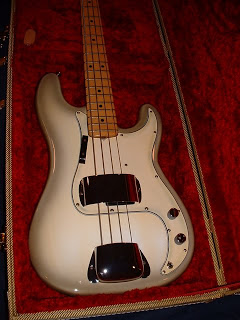
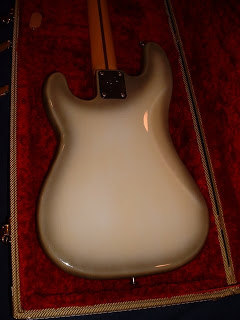
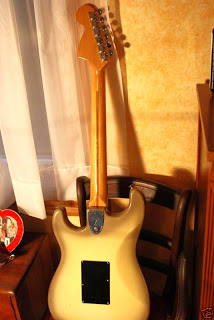
The L-2000 was actually in perfect condition - just needed a make-over. I decided not to completely strip the instrument, especially since I figured there was a reason the back of the body was finished in a dark dark walnut - something like the body was made of fairly cheap wood with a nice figured top laminated on.
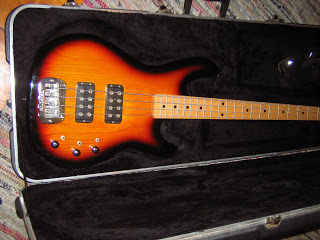

But I did sand down the entire body - and probably removed about 2/3rds of the finish in the process. Once the body surface was prepped and sanded with 220 grit - I primed it with flat white nitro primer.
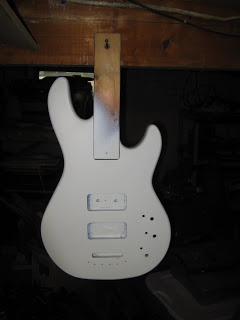
For the color coats - I knew I'd have to blend both greys and test spray them. For the light grey, I ended up using a base of gloss white lacquer, with black lacquer added - and then a small amount of dark walnut dye as well, to give a slightly brownish tint to the color. It was hard to tell how dark to make the color - if I'd had a real antigua instrument in my hands I could have better judges that, but I went by the picture of the P-bass that is posted above.
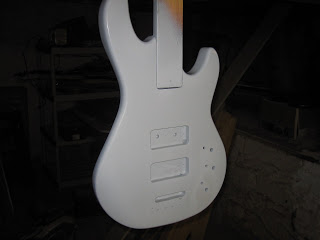

I also painted the back control panel - since I was planning on shading that as well. I sealed the base grey color with a clear gloss coat - which came in handy later on.
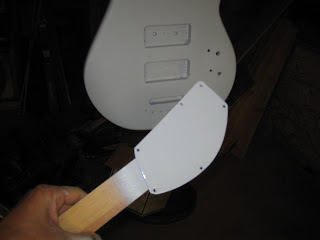
Then came the mixing of the dark grey edging. I decided to use the light grey as my base, so that the colors would be more likely to match/compliment each other. I added a substantial amount of black and more dark walnut - until I got the color I wanted. I brushed some on a panel I had sprayed to light grey base color to judge how it would look.
So then came the task of doing the edging. I wanted to get a fairly narrow band with a soft overspray, but not too wide an overspray. I used my smaller spray gun with the narrowest spray pattern and gave it a shot - outlining the front and back, and then doing the edges of the body afterwards.
Unfortunately, even though I was using fairly low air pressure, there was too much overspray, especially on the rear scoop. The colors looked good, but I wasn't happy with the overspray. So I ended up wet sanding off the dark grey edging on the front and rear faces of the body, as well as any overspray on the center of the body. The clearcoating over the base color allowed me to do this without damaging the base coat.
For the second try, I used even lower pressure and aimed away from the center of the body - and opted for a slightly wider edging overall. It wasn't really the same as on the Fender examples, but it still looked very cool I thought and resulted in a cleaner edge. I think I'd maybe have to go to using an airbrush to get the proper Fender-style edging - the small spray gun simply didn't have the finesse.
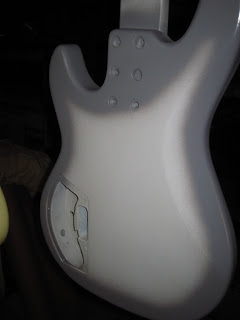
And of course I put the matching edging on the back panel.

After sending a few pictures to Steve and getting the thumbs up, I clear coated the body and back panel - after a wet sanding and buffing the bass will be re-assembled and ready to rock!


- Gibson Sg Supreme Amethyst Burst Refinish
I was contacted by a client to refinish an early 2000's SG Supreme from its factory "Midnightburst" (dark blue burst) finish to a lighter finish that would better show off the flamed maple top. The dark blue factory finish really was too dark to...
- 1976 Fender Precision Bass: Refinish To Lake Placid Blue - A Classic 60s Color!
This is a fairly straight forward refinish of a stripped Fender Precision bass body in one of Fender's classic 1960s custom colors, Lake Placid Blue. As with all of the Fender custom colors of the 60s, Lake Placid Blue was originally a car color for...
- 1978 Fender Musicmaster Bass: Detonator Yellow With Competition Stripes!
Here is a refinish of a vintage instrument, but not to a "vintage" color - rather, the owner wanted to replicate the look he had seen on Dodge's own "reissue" of the Superbee muscle car - a color that Chrysler labeled "Detonator Yellow". To really...
- 1966 Fender Jazzmaster: Aged Olympic White
< A fairly straightforward project here - a 1966 Fender Jazzmaster body that had been poorly refinished over the years and that the owner wanted to do in an aged Olympic White finish. The original Olympic White is a color thats seldom seen - its a bright...
- Squier Strat Quickie Paint Job
A customer acquired Squier of indeterminate vintage, for free I believe, and decided they wanted to "spiff" it up without spending a lot. Since the Squier had the typical poly urethane/polyester bowling ball finish and it was a heavy plywood body, we...
Guitar
G&L L-2000 Tribute Bass, in Fender Style Antigua! Does anybody remember the 70s ...??
My bass buddy Steve (actually I have a few bass buddies named Steve ..) approached me with the idea of refinishing his recent G&L L-2000 bass in something more interesting than the factory sunburst with walnut back finish it had. This bass is one of the Tribute series, which is the "more affordable" series of G&L's produced overseas.
We batted around some ideas - including Fiesta Red .. and then Steve asked me if I could do something along the lines of the fairly uncommon "antigua" finish that Fender applied to some instruments during the late 60s and then again in the mid 70s. The finish was basically a two-tone grey burst - though often these instruments have a heavily yellowed top-coat which gives them more of a brown and butter burst look.
I did some research - mostly looking for pictures online - and found that it appeared that there were really two versions of the antigua finish - the one from the 60s had a narrower and darker grey edge that looked more like an outline of the guitar body and pickguard (and appeared mostly on Fender's Coronado line) , whereas the 70s version had a wider, softer edge and a lighter grey color. The picture below has a very yellow tint to it - so its not a good reference for the actual colors, but it does illustrate the difference between the 60s version and the more common 70s version.

I found some pictures of a Precision Bass in antigua, with a relatively unyellowed finish, and a Strat, and I decided to use these two instruments as my model for Steve's L-2000.


The L-2000 was actually in perfect condition - just needed a make-over. I decided not to completely strip the instrument, especially since I figured there was a reason the back of the body was finished in a dark dark walnut - something like the body was made of fairly cheap wood with a nice figured top laminated on.
But I did sand down the entire body - and probably removed about 2/3rds of the finish in the process. Once the body surface was prepped and sanded with 220 grit - I primed it with flat white nitro primer.
For the color coats - I knew I'd have to blend both greys and test spray them. For the light grey, I ended up using a base of gloss white lacquer, with black lacquer added - and then a small amount of dark walnut dye as well, to give a slightly brownish tint to the color. It was hard to tell how dark to make the color - if I'd had a real antigua instrument in my hands I could have better judges that, but I went by the picture of the P-bass that is posted above.
I also painted the back control panel - since I was planning on shading that as well. I sealed the base grey color with a clear gloss coat - which came in handy later on.
Then came the mixing of the dark grey edging. I decided to use the light grey as my base, so that the colors would be more likely to match/compliment each other. I added a substantial amount of black and more dark walnut - until I got the color I wanted. I brushed some on a panel I had sprayed to light grey base color to judge how it would look.
So then came the task of doing the edging. I wanted to get a fairly narrow band with a soft overspray, but not too wide an overspray. I used my smaller spray gun with the narrowest spray pattern and gave it a shot - outlining the front and back, and then doing the edges of the body afterwards.
Unfortunately, even though I was using fairly low air pressure, there was too much overspray, especially on the rear scoop. The colors looked good, but I wasn't happy with the overspray. So I ended up wet sanding off the dark grey edging on the front and rear faces of the body, as well as any overspray on the center of the body. The clearcoating over the base color allowed me to do this without damaging the base coat.
For the second try, I used even lower pressure and aimed away from the center of the body - and opted for a slightly wider edging overall. It wasn't really the same as on the Fender examples, but it still looked very cool I thought and resulted in a cleaner edge. I think I'd maybe have to go to using an airbrush to get the proper Fender-style edging - the small spray gun simply didn't have the finesse.
And of course I put the matching edging on the back panel.
After sending a few pictures to Steve and getting the thumbs up, I clear coated the body and back panel - after a wet sanding and buffing the bass will be re-assembled and ready to rock!
- Gibson Sg Supreme Amethyst Burst Refinish
I was contacted by a client to refinish an early 2000's SG Supreme from its factory "Midnightburst" (dark blue burst) finish to a lighter finish that would better show off the flamed maple top. The dark blue factory finish really was too dark to...
- 1976 Fender Precision Bass: Refinish To Lake Placid Blue - A Classic 60s Color!
This is a fairly straight forward refinish of a stripped Fender Precision bass body in one of Fender's classic 1960s custom colors, Lake Placid Blue. As with all of the Fender custom colors of the 60s, Lake Placid Blue was originally a car color for...
- 1978 Fender Musicmaster Bass: Detonator Yellow With Competition Stripes!
Here is a refinish of a vintage instrument, but not to a "vintage" color - rather, the owner wanted to replicate the look he had seen on Dodge's own "reissue" of the Superbee muscle car - a color that Chrysler labeled "Detonator Yellow". To really...
- 1966 Fender Jazzmaster: Aged Olympic White
< A fairly straightforward project here - a 1966 Fender Jazzmaster body that had been poorly refinished over the years and that the owner wanted to do in an aged Olympic White finish. The original Olympic White is a color thats seldom seen - its a bright...
- Squier Strat Quickie Paint Job
A customer acquired Squier of indeterminate vintage, for free I believe, and decided they wanted to "spiff" it up without spending a lot. Since the Squier had the typical poly urethane/polyester bowling ball finish and it was a heavy plywood body, we...
